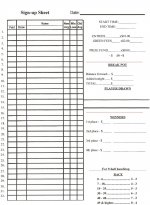hello all !
i play in a very fine establishment's friday night 9 ball $20 tournaments...
the format is arbitrary in that players are assigned handicaps 3-7+ and match races are as an example a 6 vs a 5 then the race is 4-3 ...
i am quite a bit older than when i formerly played there (65 now) but i was assigned a 6 handicap based on my play from 10 years ago ... and yes it has declined with age ...
im not complaining it just occurred to me much like our golf course handicaps back in the day were self adjusting (for gambling we did not use USGA we had our own sheet of one's last ten scores IN THE GAME and that determined your number NO NEGOTIATION ... but it was extremely fair
that said I have noticed a decline in players at our 9 ball tournaments and i suspect that , like myself , some are just weary of the fact that they cannot play to their handi and are making a weekly donation ...
my premise here is that if players believe in and actually do have a fair self adjusting handicap system they will be repeat customers for life ...
So my question is "Does anyone or is anyone aware of a handi system that adjusts every tournament based on results and if so what is it ?"
my idea is to add a half point to a player that say goes 3-2 and add a full point for a 4-2 ...while subtracting a half for 1-2 and subtracting a point for 0-2 etc with the limit beind a 1 point move per tournament...
this is in house so we can control our own data base
suggestions ? we need database info software and we also need a new hopefully online tournament bracket software
thx
i play in a very fine establishment's friday night 9 ball $20 tournaments...
the format is arbitrary in that players are assigned handicaps 3-7+ and match races are as an example a 6 vs a 5 then the race is 4-3 ...
i am quite a bit older than when i formerly played there (65 now) but i was assigned a 6 handicap based on my play from 10 years ago ... and yes it has declined with age ...
im not complaining it just occurred to me much like our golf course handicaps back in the day were self adjusting (for gambling we did not use USGA we had our own sheet of one's last ten scores IN THE GAME and that determined your number NO NEGOTIATION ... but it was extremely fair
that said I have noticed a decline in players at our 9 ball tournaments and i suspect that , like myself , some are just weary of the fact that they cannot play to their handi and are making a weekly donation ...
my premise here is that if players believe in and actually do have a fair self adjusting handicap system they will be repeat customers for life ...
So my question is "Does anyone or is anyone aware of a handi system that adjusts every tournament based on results and if so what is it ?"
my idea is to add a half point to a player that say goes 3-2 and add a full point for a 4-2 ...while subtracting a half for 1-2 and subtracting a point for 0-2 etc with the limit beind a 1 point move per tournament...
this is in house so we can control our own data base
suggestions ? we need database info software and we also need a new hopefully online tournament bracket software
thx
